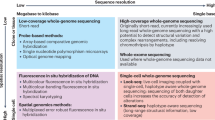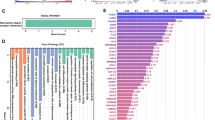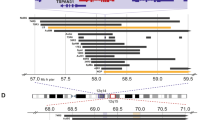Abstract
p58cdc2L1, a protein kinase implicated in apoptotic signaling, is one of eight separate kinases encoded by three tandemly duplicated and linked genes, which we have termed PITSLRE A, B and C. One allele of this complex on chromosome 1 was either deleted or translocated in each of 18 neuroblastoma cell lines with cytogenetically apparent 1 p alterations. A protein encoded by this locus, PITSLREγ1, was absent in three of the lines and a smaller, apparently truncated, PITSLRE polypeptide was found in another line. These findings identify a novel gene complex on chromosome 1 that encodes a protein kinase subfamily. We suggest that the PITSLRE locus may harbour one or more tumour suppressor genes affected by chromosome 1p36 modifications in neuroblastoma.
This is a preview of subscription content, access via your institution
Access options
Subscribe to this journal
Receive 12 print issues and online access
$209.00 per year
only $17.42 per issue
Buy this article
- Purchase on Springer Link
- Instant access to full article PDF
Prices may be subject to local taxes which are calculated during checkout
Similar content being viewed by others
References
Brodeur, G.M. et al. Cytogenetic features of human neuroblastomas and cell lines. Cancer Res. 41, 4678–4686 (1981).
Brodeur, G.M. et at. Statistical analysis of cytogenetic abnormalities in human cancer cells. Cancer Gen. Cytogenet. 7, 137–152 (1982).
Gilbert, F. et al. Human neuroblastomas and abnormalities of chromosomes 1 and 17. Cancer Res. 44, 5444–5449 (1984).
Brodeur, G.M. et al. Amplification of N-myc in untreated human neuroblastomas correlates with advanced disease stage. Science 224, 1121–1124 (1984).
Knudson, A.G. Antioncogenes and human cancer. Proc. natn. Acad. Sci. U.S.A. 90, 10914–10921 (1993).
Weith, A. et al. Neuroblastoma consensus deletion maps to 1 p36.1–2. Genes Chrom. Cancer 1, 67–78 (1989).
Zehnbauer, B.A., Small, D., Brodeur, G.M., Seeger, R. & Vogelstein, B. Characterization of N-myc amplification units in human neuroblastoma cells. Molec. cell. Biol. 8, 522–530 (1988).
Cheng, J.M. et al. Preferential amplification of the paternal allele of the N-myc gene in human neuroblastoma. Nature Genet. 4, 191–194 (1993).
Fong, C. et al. Loss of heterozygosity for chromosomes 1 or 14 defines subsets of advanced neuroblastomas. Cancer Res. 52, 1780–1785 (1992).
Fong, C-T. et al. Loss of heterozygosity for the short arm of chromosome 1 in human neuroblastomas: Correlation with N-myc amplification. Proc. natn. Acad. Sci. U.S.A. 86, 3753–3757 (1989).
Caron, H. et al. Allelic loss of chromosome 1p36 in neuroblastoma is of preferential maternal origin and correlates with N-myc amplification. Nature Genet. 4, 187–190 (1993).
Bunnell, B.A., Heath, L.S., Adams, D.E., Lahti, J.M. & Kidd, V.J. Increased expression of a 58-kDa protein kinase feads to changes in the CHO celt cycle. Proc. natn. Acad. Sci. U.S.A. 87, 7467–7471 (1990).
Eipers, P.G., Barnoski, B.L., Han, J., Carroll, A.J. & Kidd, V.J. Localization of the expressed human p58 protein kinase chromosomal gene to chromosome 1p36 and a highly related sequence to chromosome 15. Genomics 11, 621–629 (1991).
Xiang, J., Lahti, J.M., Grenet, J., Easton, J. & Kidd, V.J. Molecular cloning and expression of alternatively spliced PITSLRE protein kinase isoforms. J. biol. Chem. (in the press).
Bunnell, B.A., Fillmore, H., Gregory, P. & Kidd, V.J. A dominant negative mutation In two proteins created by ectopic expression of an AU-rich 3′ untranslated region. Somat. Cell molec. Genet. 16, 151–162 (1990).
Meyerson, M. et al. A family of human cdc2-related protein kinases. EMBO J. 11, 2909–2917 (1992).
Christiansen, H. et al. Chromosome 1 interphase-cytogenetics In 32 primary neuroblastoma of different clinical stages. Adv. Neuroblast. Res. 3, 99–105 (1991).
Kamps, M.P., Look, A.T. & Baltimore, D. The human t(1:19) translocation in pre-B-ALL produces multiple nuclear E2A-Pbx1 fusion proteins with differing transforming potentials. Genes Devel. 5, 358–368 (1991).
Eipers, P.G., Lahti, J.M. & Kidd, V.J. Structure and expression of the human p58clk-1 protein kinase chromosomal gene. Genomics 13, 613–621 (1992).
Easton, J. & Kidd, V.J. Analysis of the 5′ flanking sequences from the human p58 (PITLSRE β1) gene. Gene (in the press).
Dietrich, W.F. et al. Genetic identification of Mom-1, a major modifier locus affecting Min-induced intestinal neoplasia in the mouse. Cell 75, 631–640 (1993).
Mock, B.A., Padlan, C., Kozak, C.A. & Kidd, V.J. The gene for the mouse p58cdc2L1 (Pitslre 1) protein kinase maps to chromosome 4. Mamm. Genome 5, 191–192 (1994).
Yonish-Rouach, E. et al. Wild-type p53 induces apoptosis of myeloid leukaemic cells that is inhibited by Interleukin-6. Nature 352, 345–347 (1991).
Lowe, S.W., Ruby, H.E., Jacks, T. & Housman, D.E. p53-Depandentapoptosis modulates the cytotoxicity of anticancer agents. Cell 74, 957–967 (1993).
Cleary, M.L. & Sklar, J. Nudeotide sequence of a t (14:18) chromosomal breakpoint in follicular lymphoma and demonstration of a breakpoint-cluster region near a transcriptionally active locus on chromosome 18. Proc. natn. Acad. Sci. U.S.A. 82, 7439–7443 (1985).
Bakhshi, A. et al. Cloning the chromosomal breakpoint of t(14:18) human lymphomas: clustering around JH on chromosome 14 and near a transcriptional unit on 18. Cell 41, 899–906 (1985).
Tsujimoto, Y., Gorham, J., Cossman, J., Jaffe, E., & Croce, C.M. The t(14:18) chromosome translocations involved in B-cell neoplasias result from mistakes in VDJ joining. Science 229, 1390–1393 (1985).
Evan, G.I. et al. Induction of apoptosis in fibroblasts by c-myc protein. Cell 69, 119–128 (1992).
Askew, D.S., Ashmun, R.A., Simmons, B.C. & Cleveland, J.L. Constitutive c-myc expression in an IL-3-dependent myeloid cell line suppresses cell cycle arrest and accelerates apoptosis. Oncogene 6, 1915–1922 (1991).
Bissonnette, R.P., Echeverri, F., Mahboubi, A. & Green, D.R. Apoptotic cell death induced by c-myc is inhibited by bcl-2. Nature 359, 552–554 (1992).
Fanidi, A., Harrington, E.A. & Evan, G.I. Cooperative interaction between c-myc and bcl-2 proto-oncogene. Nature 359, 554–556 (1992).
Dracopoli, N.C. et al. Loss of alleles from the distal short arm of chromosome 1 occurs late in melanoma tumor progression. Proc. natn. Acad. Sci. U.S.A. 86, 4614–4618 (1989).
Simon, D., Knowles, B.B. & Weith, A. Abnormalities of chromosome 1 and loss of heterozygosity on 1p primary hepatomas. Oncogene 6, 765–770 (1991).
Mathew, C.G. et al. Deletion of gene on chromosome 1 in endocrine neoplasia. Nature 328, 524–525 (1987).
Hague, A., Hanlon, K.A. & Paraskeva, C. Clonal evolution and tumor progression in two human colorectal adenoma-derived cell lines in vitro: the involvement of chromosome 1 abnormalities. Int. J. Onc. 1, 201–208 (1992).
Johnson, M.R., Look, A.T., DeClue, J.E., Valentine, M.B. & Lowy, D.R. Inactivatlon of the NF1 gene in human melanoma and neuroblastoma cell lines without impared regulation of GTP-Ras. Proc. natn. Acad. Sci. U.S.A. 90, 5539–5543 (1993).
Author information
Authors and Affiliations
Rights and permissions
About this article
Cite this article
Lahti, J., Valentine, M., Xiang, J. et al. Alterations in the PITSLRE protein kinase gene complex on chromosome 1p36 in childhood neuroblastoma. Nat Genet 7, 370–375 (1994). https://doi.org/10.1038/ng0794-370
Received:
Accepted:
Issue Date:
DOI: https://doi.org/10.1038/ng0794-370
This article is cited by
-
Whole-exome sequencing of familial esophageal squamous cell carcinoma identified rare pathogenic variants in new predisposition genes
Clinical and Translational Oncology (2020)
-
The SDF-1 rs1801157 Polymorphism is Associated with Cancer Risk: An Update Pooled Analysis and FPRP Test of 17,876 Participants
Scientific Reports (2016)
-
Genome instability model of metastatic neuroblastoma tumorigenesis by a dictionary learning algorithm
BMC Medical Genomics (2015)
-
The MYCN oncogene is a direct target of miR-34a
Oncogene (2008)
-
Suppression of Myc oncogenic activity by ribosomal protein haploinsufficiency
Nature (2008)



